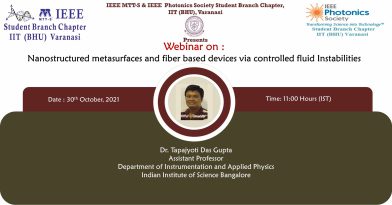
-
Saturday, October 30, 2021 11:00 am - 12:00 pm(New Delhi Time) Add to my calendar
Nanostructured Metasurfaces and Fiber Based Devices via Controlled Fluid Instabilities
Dr. Tapajyoti Das Gupta
Indian Institute of Science Bangalore
Abstract: Modern devices require the tuning of the size, shape and spatial arrangement of nano- objects and their assemblies with nanometer scale precision, over large-area and sometimes soft substrates. Such stringent multi-scale and mechanical requirements are beyond the reach of conventional lithography techniques or simpler self-assembly approaches. In this talk, at first we will demonstrate an unprecedented control over the fluid instabilities of thin glass films as a simple approach for the self-assembly of advanced all-dielectric metasurfaces1,2. We show and model the tailoring of the position, shape, size and inter-particle distance of nano-objects with feature sizes below ten nanometers. This simple and versatile approach can generate optical nanostructures over tens-of-centimeters sized rigid and soft substrates, with better optical performance and a resolution on par with advanced lithography-based processes. By a programmable control of the nanoimprinting method and the initial film thickness we show that we can achieve tunable particle size and lattice using the same master Silicon mold. To underline the potential of our approach, we demonstrate various optical phenomenon. Our ability to fabricate the metasurfaces on stretchable substrates without undergoing any lift off process finds application in mechano-chromic sensors. The ability to fabricate quasi 3D structures find application in phase tunable metasurfaces. Lastly, by having an unprecedented control over the lattice and particle size we demonstrate sharp Fano resonances with the highest Quality factor ~300 in the visible to date. Such resonances are exploited to realize high efficiency protein monolayer detection and to generate strong Second harmonic generation highlighting the unprecedented reconciliation between state-of-the-art optical performance and simple self-assembly fabrication approaches. In the second part, briefly I will talk of another novel fabrication technique of wearable fibers via thermal drawing. In particular, via this method we will demonstrate kms long fiber fabrications which can be integrated into clothings. Such scalable technique will be demonstrated to fabricate photodetectors and stretchable photonics and electronic sensor. Lastly a vision of newly formed Lab LANSPE (Laboratory of Nanostructures for Photonics and Electronics) will be briefly demonstrated.
Speaker’s Bio:Tapajyoti Das Gupta obtained his BSc and Btech in Physics and Radio physics respectively from University of Calcutta in 2006 and 2009. He then moved to France where he obtained his MSc in nanoscience from École Polytechnique (l’X) in 2012 and PhD in Condensed Matter Physics lab (PMC) from the same institute in 2015 under Prof. Thierry GACOIN and Alistair ROWE. He then joined prof. Fabien Sorin’s lab of Fiber Optics and Photonics Devices (FIMAP) in École Polytechnique Fédérale de Lausanne (EPFL) during 2015 December-2019 November. He also served in the Electrical Engineering department in Indian Institute of Technology, Kanpur (IITK) for five months from January 2020 to May 2020, before joining the Department of Instrumentation and Applied Physics in July 2020.
This event is organised by IEEE MTT Society Student Branch Chapter and IEEE Photonics Society Student Branch Chapter IITBHU Varanasi.